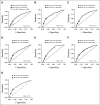Multi-Institutional Validation of a Mammography-Based Breast Cancer Risk Model
- PMID: 34767469
- PMCID: PMC9148689
- DOI: 10.1200/JCO.21.01337
Multi-Institutional Validation of a Mammography-Based Breast Cancer Risk Model
Abstract
Purpose: Accurate risk assessment is essential for the success of population screening programs in breast cancer. Models with high sensitivity and specificity would enable programs to target more elaborate screening efforts to high-risk populations, while minimizing overtreatment for the rest. Artificial intelligence (AI)-based risk models have demonstrated a significant advance over risk models used today in clinical practice. However, the responsible deployment of novel AI requires careful validation across diverse populations. To this end, we validate our AI-based model, Mirai, across globally diverse screening populations.
Methods: We collected screening mammograms and pathology-confirmed breast cancer outcomes from Massachusetts General Hospital, USA; Novant, USA; Emory, USA; Maccabi-Assuta, Israel; Karolinska, Sweden; Chang Gung Memorial Hospital, Taiwan; and Barretos, Brazil. We evaluated Uno's concordance index for Mirai in predicting risk of breast cancer at one to five years from the mammogram.
Results: A total of 128,793 mammograms from 62,185 patients were collected across the seven sites, of which 3,815 were followed by a cancer diagnosis within 5 years. Mirai obtained concordance indices of 0.75 (95% CI, 0.72 to 0.78), 0.75 (95% CI, 0.70 to 0.80), 0.77 (95% CI, 0.75 to 0.79), 0.77 (95% CI, 0.73 to 0.81), 0.81 (95% CI, 0.79 to 0.82), 0.79 (95% CI, 0.76 to 0.83), and 0.84 (95% CI, 0.81 to 0.88) at Massachusetts General Hospital, Novant, Emory, Maccabi-Assuta, Karolinska, Chang Gung Memorial Hospital, and Barretos, respectively.
Conclusion: Mirai, a mammography-based risk model, maintained its accuracy across globally diverse test sets from seven hospitals across five countries. This is the broadest validation to date of an AI-based breast cancer model and suggests that the technology can offer broad and equitable improvements in care.
Conflict of interest statement
Figures


Comment in
-
More Than Incremental: Harnessing Machine Learning to Predict Breast Cancer Risk.J Clin Oncol. 2022 Jun 1;40(16):1713-1717. doi: 10.1200/JCO.21.02733. Epub 2022 Mar 4. J Clin Oncol. 2022. PMID: 35245093 No abstract available.
-
Risk Assessment in Population-Based Breast Cancer Screening.J Clin Oncol. 2022 Jul 10;40(20):2279-2280. doi: 10.1200/JCO.21.02827. Epub 2022 Apr 22. J Clin Oncol. 2022. PMID: 35452252 No abstract available.
-
Artificial Intelligence Risk Model (Mirai) Delivers Robust Generalization and Outperforms Tyrer-Cuzick Guidelines in Breast Cancer Screening.J Clin Oncol. 2022 Jul 10;40(20):2280-2281. doi: 10.1200/JCO.21.02908. Epub 2022 Apr 22. J Clin Oncol. 2022. PMID: 35452262 No abstract available.
-
Beyond the AJR: Validation of an Artificial Intelligence Breast Cancer Risk Assessment Model Across Diverse International Cohorts.AJR Am J Roentgenol. 2022 Sep;219(3):524. doi: 10.2214/AJR.22.27436. Epub 2022 Feb 2. AJR Am J Roentgenol. 2022. PMID: 35576517 No abstract available.
References
-
- Smith RA, Andrews KS, Brooks D, et al. Cancer screening in the United States, 2019: A review of current American Cancer Society guidelines and current issues in cancer screening. CA Cancer J Clin. 2019;69:184–210. - PubMed
-
- Bevers TB, Ward JH, Arun BK, et al. Breast cancer risk reduction, version 2. 2015. J Natl Compr Cancer Netw. 2015;13:880–915. - PubMed
-
- Tyrer J, Duffy SW, Cuzick J. A breast cancer prediction model incorporating familial and personal risk factors. Stat Med. 2004;23:1111–1130. - PubMed
-
- Yala A, Mikhael PG, Strand F, et al. Toward robust mammography-based models for breast cancer risk. Sci Transl Med. 2021;13:eaba4373. - PubMed
-
- Gail MH, Costantino JP, Pee D, et al. Projecting individualized absolute invasive breast cancer risk in African American women. J Natl Cancer Inst. 2007;99:1782–1792. - PubMed
Publication types
MeSH terms
LinkOut - more resources
Full Text Sources
Other Literature Sources
Medical

